View in other NatureServe Network Field Guides
NatureServe
Montana
Utah
Wyoming
Idaho
Wisconsin
British Columbia
South Carolina
Yukon
California
New York
Alpine Collomia - Collomia debilis var. camporum
State Rank Reason (see State Rank above)
Only known from a few sites in western Montana and Lemhi County, Idaho, from low elevation scree, talus or rocky slopes. Negative impacts from human disturbance and weed invasion are possible. Current status of most of the documented locations is not known. Survey and monitoring data are needed.
- Details on Status Ranking and Review
Population Size
Score2-3 - Very Small to Small: Population size is imprecisely known but is believed to be <10,000 individuals.
Range Extent
Score2-3 - Local or Regional Endemic: Species has a small to very small range, though its distribution is either imprecisely documented or information to precisely categorize it was lacking at the time its status was reviewed.
CommentEndemic to western Montana and central Idaho.
Area of Occupancy
Score2-3 - Very Low to Low. Occurs in 10 or fewer Subwatersheds (6th Code HUC’s), though the species' distribution is not sufficiently documented to place it within one class.
Environmental Specificity
Score2 - High: Species is restricted to a highly specialized and limited habitat and is typically dependent upon unaltered, high-quality habitat (C Values of 8-10).
Trends
Score1-2 - Minor to Moderate Declines:
CommentActual trends are unknown due to a lack of data, though low elevation populations near Missoula may have experiened some negative impacts.
Threats
Score2 - High: 31-70% of the populations are being negatively impacted or are likely to be impacted by one or more activities or agents, which are expected to result in decreased populations and/or habitat quality and/or quantity.
Intrinsic Vulnerability
Score1 - Moderate Vulnerability: Specific biological attributes, unusual life history characteristics or limited reproductive potential makes the species susceptible to extirpation from stochastic events or other adverse impacts to its habitat and slow to recover.
Raw Conservation Status Score
Score
12 to 16 total points scored out of a possible 19.
General Description
See species description.
Diagnostic Characteristics
Intergrades with variety debilis. Variety camporum generally has narrow, entire leaves with gradually tapered petioles. In contrast, variety debilis has lobed or entire leaves that are wider and generally have a more distinct petiole. Variety camporum also typically grows at lower elevations, though the varieties overlap in habitat.
Species Range
Montana Range
Range Descriptions
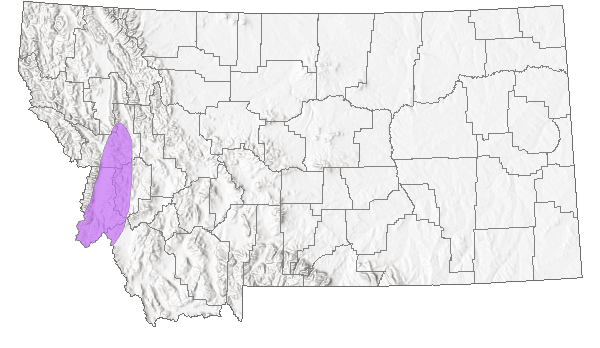
 Native
Native
Observations in Montana Natural Heritage Program Database
Number of Observations: 11
(Click on the following maps and charts to see full sized version)
Map Help and Descriptions
Relative Density
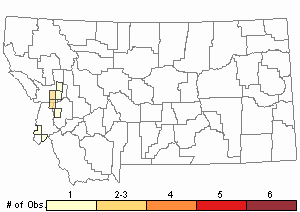
Recency
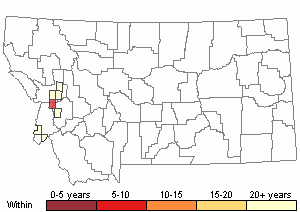
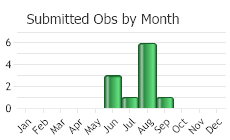
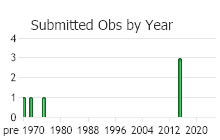
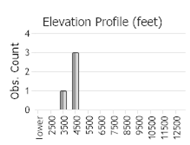 (Observations spanning multiple months or years are excluded from time charts)
(Observations spanning multiple months or years are excluded from time charts)
Habitat
Low elevation, scree, talus and rocky slopes from near the valley bottoms to the montane zone.
National Vegetation Classification System Groups Associated with this Species
Forest and Woodland
Montane - Subalpine Forest and Woodland
Sparse and Barren
Sparse and Barren
Stewardship Responsibility
Threats or Limiting Factors
STATE THREAT SCORE REASON
Reported threats to Montana’s populations of Alpine Collomia are currently assigned as unknown (MTNHP Threat Assessment 2021). Spotted Knapweed (Centaurea stoebe) is found in the vicinity of some populations, but reports indicate that weeds are unlikely to spread into scree habitat where Alpine Collomia is found. Little is known about the existing condition or presence of threats at other populations.
References
- Literature Cited AboveLegend:
 View Online Publication
View Online Publication MTNHP Threat Assessment. 2021. State Threat Score Assignment and Assessment of Reported Threats from 2006 to 2021 for State-listed Vascular Plants. Botany Program, Montana Natural Heritage Program, Helena, Montana.
MTNHP Threat Assessment. 2021. State Threat Score Assignment and Assessment of Reported Threats from 2006 to 2021 for State-listed Vascular Plants. Botany Program, Montana Natural Heritage Program, Helena, Montana.
- Additional ReferencesLegend:
 View Online Publication
View Online Publication
Do you know of a citation we're missing? Lesica, P., M.T. Lavin, and P.F. Stickney. 2012. Manual of Montana Vascular Plants. Fort Worth, TX: BRIT Press. viii + 771 p.
Lesica, P., M.T. Lavin, and P.F. Stickney. 2012. Manual of Montana Vascular Plants. Fort Worth, TX: BRIT Press. viii + 771 p. Lesica, P., M.T. Lavin, and P.F. Stickney. 2022. Manual of Montana Vascular Plants, Second Edition. Fort Worth, TX: BRIT Press. viii + 779 p.
Lesica, P., M.T. Lavin, and P.F. Stickney. 2022. Manual of Montana Vascular Plants, Second Edition. Fort Worth, TX: BRIT Press. viii + 779 p.
- Web Search Engines for Articles on "Alpine Collomia"





